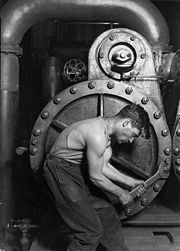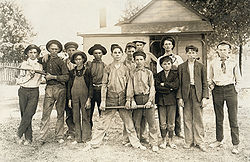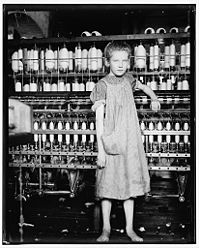
Lewis Hine
Encyclopedia

United States
The United States of America is a federal constitutional republic comprising fifty states and a federal district...
sociologist
Sociology
Sociology is the study of society. It is a social science—a term with which it is sometimes synonymous—which uses various methods of empirical investigation and critical analysis to develop a body of knowledge about human social activity...
and photographer. Hine used his camera as a tool for social reform. His photographs were instrumental in changing the child labor laws in the United States.
Early life
Lewis W. Hine was born in Oshkosh, WisconsinOshkosh, Wisconsin
As of the census of 2000, there were 62,916 people, 24,082 households, and 13,654 families residing in the city. The population density was 2,662.2 people per square mile . There were 25,420 housing units at an average density of 1,075.6 per square mile...
in 1874. After his father died in an accident, he began working and saved his money for a college education. Hine studied sociology
Sociology
Sociology is the study of society. It is a social science—a term with which it is sometimes synonymous—which uses various methods of empirical investigation and critical analysis to develop a body of knowledge about human social activity...
at the University of Chicago
University of Chicago
The University of Chicago is a private research university in Chicago, Illinois, USA. It was founded by the American Baptist Education Society with a donation from oil magnate and philanthropist John D. Rockefeller and incorporated in 1890...
, Columbia University
Columbia University
Columbia University in the City of New York is a private, Ivy League university in Manhattan, New York City. Columbia is the oldest institution of higher learning in the state of New York, the fifth oldest in the United States, and one of the country's nine Colonial Colleges founded before the...
and New York University
New York University
New York University is a private, nonsectarian research university based in New York City. NYU's main campus is situated in the Greenwich Village section of Manhattan...
. He became a teacher in New York City
New York City
New York is the most populous city in the United States and the center of the New York Metropolitan Area, one of the most populous metropolitan areas in the world. New York exerts a significant impact upon global commerce, finance, media, art, fashion, research, technology, education, and...
at the Ethical Culture School, where he encouraged his students to use photography
Photography
Photography is the art, science and practice of creating durable images by recording light or other electromagnetic radiation, either electronically by means of an image sensor or chemically by means of a light-sensitive material such as photographic film...
as an educational medium. The classes traveled to Ellis Island
Ellis Island
Ellis Island in New York Harbor was the gateway for millions of immigrants to the United States. It was the nation's busiest immigrant inspection station from 1892 until 1954. The island was greatly expanded with landfill between 1892 and 1934. Before that, the much smaller original island was the...
in New York Harbor
New York Harbor
New York Harbor refers to the waterways of the estuary near the mouth of the Hudson River that empty into New York Bay. It is one of the largest natural harbors in the world. Although the U.S. Board of Geographic Names does not use the term, New York Harbor has important historical, governmental,...
, photographing the thousands of immigrants who arrived each day. Between 1904 and 1909, Hine took over 200 plates (photographs), and eventually came to the realization that his vocation was photojournalism.
Photojournalism


Russell Sage Foundation
The Russell Sage Foundation is the principal American foundation devoted exclusively to research in the social sciences. Founded in 1907 and headquartered in New York City, the foundation is a research center, a funding source for studies by scholars at other institutions, and a key member of the...
. Here Hine photographed life in the steel-making districts and people of Pittsburgh, Pennsylvania
Pittsburgh, Pennsylvania
Pittsburgh is the second-largest city in the US Commonwealth of Pennsylvania and the county seat of Allegheny County. Regionally, it anchors the largest urban area of Appalachia and the Ohio River Valley, and nationally, it is the 22nd-largest urban area in the United States...
, for the influential sociological study called the Pittsburg Survey. In 1908, he became the photographer for the National Child Labor Committee (NCLC)
National Child Labor Committee
The National Child Labor Committee, or NCLC, is a private, non-profit organization in the United States that serves as a leading proponent for the national child labor reform movement...
, leaving his teaching position. Over the next decade, Hine documented child labor in American industry to aid the NCLC's lobbying efforts to end the practice.

World War I
World War I , which was predominantly called the World War or the Great War from its occurrence until 1939, and the First World War or World War I thereafter, was a major war centred in Europe that began on 28 July 1914 and lasted until 11 November 1918...
, he photographed American Red Cross
American Red Cross
The American Red Cross , also known as the American National Red Cross, is a volunteer-led, humanitarian organization that provides emergency assistance, disaster relief and education inside the United States. It is the designated U.S...
relief work in Europe. In the 1920s and early 1930s, Hine made a series of "work portraits," which emphasized the human contribution to modern industry. In 1930, Hine was commissioned to document the construction of The Empire State Building. Hine photographed the workers in precarious positions while they secured the iron and steel framework of the structure, taking many of the same risks the workers endured. In order to obtain the best vantage points, Hine was swung out in a specially designed basket 1,000 feet above Fifth Avenue.
During the Great Depression
Great Depression
The Great Depression was a severe worldwide economic depression in the decade preceding World War II. The timing of the Great Depression varied across nations, but in most countries it started in about 1929 and lasted until the late 1930s or early 1940s...
, he again worked for the Red Cross, photographing drought relief in the American South, and for the Tennessee Valley Authority
Tennessee Valley Authority
The Tennessee Valley Authority is a federally owned corporation in the United States created by congressional charter in May 1933 to provide navigation, flood control, electricity generation, fertilizer manufacturing, and economic development in the Tennessee Valley, a region particularly affected...
(TVA), documenting life in the mountains of eastern Tennessee. He also served as chief photographer for the Works Progress Administration
Works Progress Administration
The Works Progress Administration was the largest and most ambitious New Deal agency, employing millions of unskilled workers to carry out public works projects, including the construction of public buildings and roads, and operated large arts, drama, media, and literacy projects...
's (WPA) National Research Project, which studied changes in industry and their effect on employment. Hine was also a member of the faculty of the Ethical Culture Fieldston School
Ethical Culture Fieldston School
The Ethical Culture Fieldston School, known as "Fieldston", is a private "independent" school in New York City and a member of the Ivy Preparatory School League. It has about 1600 students and a staff of 400 people , led by Dr. Damian J...
.
The Library of Congress
Library of Congress
The Library of Congress is the research library of the United States Congress, de facto national library of the United States, and the oldest federal cultural institution in the United States. Located in three buildings in Washington, D.C., it is the largest library in the world by shelf space and...
holds more than five thousand Hine photographs, including examples of his child labor and Red Cross photographs, his work portraits, and his WPA and TVA images. Other large institutional collections include nearly ten thousand of Hine's photographs and negatives held at the George Eastman House
George Eastman House
The George Eastman House is the world's oldest museum dedicated to photography and one of the world's oldest film archives, opened to the public in 1949 in Rochester, New York, USA. World-renowned for its photograph and motion picture archives, the museum is also a leader in film preservation and...
and almost five thousand NCLC photographs at the Albin O. Kuhn Library & Gallery of the University of Maryland, Baltimore County.
Later life of Lewis Hine
In 1936, Hine was selected as the photographer for the National Research Project of the Works Projects Administration, but his work there was never completed.The last years of his life were filled with professional struggles due to loss of government and corporate patronage. Few people were interested in his work, past or present, and Hine lost his house and applied for welfare. He died at age 66 on November 3, 1940 at Dobbs Ferry Hospital in Dobbs Ferry, New York
Dobbs Ferry, New York
Dobbs Ferry is a village in Westchester County, New York, United States. The population was 10,875 at the 2010 census.The Village of Dobbs Ferry is located in, and is a part of, the town of Greenburgh...
, after an operation.
After Lewis Hine's death his son Corydon donated his prints and negatives to the Photo League, which was dismantled in 1951. The Museum of Modern Art
Museum of Modern Art
The Museum of Modern Art is an art museum in Midtown Manhattan in New York City, on 53rd Street, between Fifth and Sixth Avenues. It has been important in developing and collecting modernist art, and is often identified as the most influential museum of modern art in the world...
was offered his pictures but did not accept them; but the George Eastman House
George Eastman House
The George Eastman House is the world's oldest museum dedicated to photography and one of the world's oldest film archives, opened to the public in 1949 in Rochester, New York, USA. World-renowned for its photograph and motion picture archives, the museum is also a leader in film preservation and...
in Rochester, New York
Rochester, New York
Rochester is a city in Monroe County, New York, south of Lake Ontario in the United States. Known as The World's Image Centre, it was also once known as The Flour City, and more recently as The Flower City...
did.
Notable photographs
- Child Labor: Girls in Factory (1908)
- Breaker Boys (1910)
- Steam Fitter (1920)
- Workers, Empire State Building (1931)
See also
- House CallsHouse Calls (documentary)House Calls is 2006 Canadian documentary film about Mark Nowaczynski, a physician and photographer who documents the lives of many of his elderly patients...
, a documentary about physician and photographer Mark Nowaczynski, who was inspired by Hine to photograph elderly patients. - Kate Sampsell-Willmann, Lewis Hine as Social Critic (Jackson: University Press of Mississippi, 2009).
External links
- Photo of Lewis Hine
- Library of Congress NCLC Prints & Photographs
- Lewis Hine Collection at the University of Maryland, Baltimore County (5000 photos)
- Dozens of high-resolution Hine photos with the original captions
- Lewis Hine Project: Nationally known project to locate and interview descendants of child laborers photographed by Hine
- Lewis Hine : Immigration & The Progressive Era
- Youtube Video: "United States Child Labor, 1908-1920: As Seen Through the Lens of Sociologist and Photographer Lewis W. Hine"
- Lewis Hine, Selected Prints
- Further works about Hine (from WorldCatWorldCatWorldCat is a union catalog which itemizes the collections of 72,000 libraries in 170 countries and territories which participate in the Online Computer Library Center global cooperative...
) - Further works about Hine (from WorldCat), online material only
- Further works by Hine (from WorldCat)
- Further works by Hine (from WorldCat), online material only

